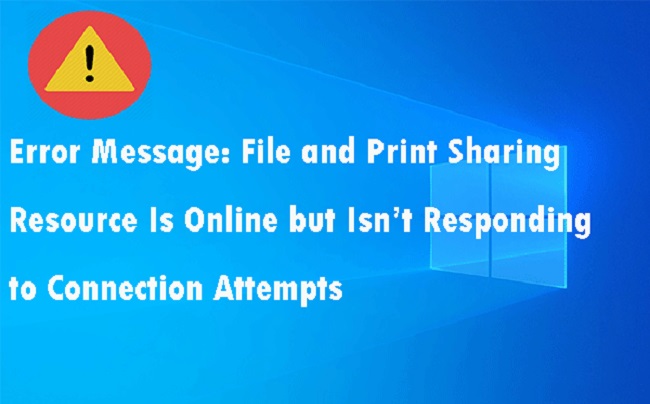After trying to access one or more shared folders across the local network, several users are receiving the error “file and print sharing resource is online but isn’t responding to connection attempts” while using the Windows Network Diagnostics tool.
Users typically remark that they can see the files over the network but are unable to access any of them. Most complaints of the problem have been on Windows 7, although there have also been reports on Windows 8.1 and 10.

Contents
Method 1: Facilitating The Ability To Locate Any Computer System
If you’re using Windows 10 or Windows 8.1 and are having this problem, make sure that all of the affected PCs are in the “discoverable” mode.
Several customers seeing the “file and print sharing resource is online but isn’t responding to connection attempts” error reported that the issue was removed totally after confirming that network discovery is configured appropriately.
Here’s how to make sure your devices can be seen on your network using the Settings app. Remember that the procedure may vary significantly depending on whether or not you are utilising a wired Ethernet connection or a wireless Wi-Fi adaptor.
It’s important to make sure you’re connecting in the way that’s specified for your chosen technique.
Using an Ethernet adaptor to hook up
Step 1: Press Windows key + R to open up a Run dialogue box. Entering “ms-settings:network-ethernet” into the search bar will take you to the Ethernet section of the Settings app.
Step 2: To make an adapter discoverable, head to the Ethernet tab, and click on the right side where the adapters are listed.
Step 3: Then, under Network profile, make sure that the network is set to Private.
Step 4: This process must be repeated on each computer in this network.
Utilizing a wireless network adaptor
Step 1: Press Windows key + R to open up a Run dialogue box. The Wi-Fi section of the Settings app can be accessed by typing “ms-settings:network-wifi” and hitting the Enter key.
Step 2: Then, select the desired wireless network for the network sharing purposes from the menu on the right (your computer needs to be connected to it).
Step 3: Just as before, make sure your network can be seen by other devices by setting the profile to Private under Network.
Step 4: This process must be repeated on each computer in this network.
If you followed the steps in the previous section, your computers should now be easily accessible via the intranet. By clicking the Status button, you can see if your current network profile is set to Private.
To bring up the Run dialogue box, use the Windows key plus R. To access the Network Status page in Settings, type “ms-settings:network-status” followed by Enter.
You may rest assured that everything is in order if you check the Network status and observe that you are utilising a Private network profile and that all of the PCs engaged in the operation are set up to be discoverable.
To check if the “file and print sharing resource is online but isn’t responding to connection attempts” error has been fixed, simply repeat the steps that led to the message before attempting them again.
Proceed to the next solution if you continue to receive the same error message.
Method 2: Installing every pending Windows update
If you’re running a version of Windows 10 older than 1703 and encountering an error message from Network Diagnostic, you may be dealing with a known issue.
Although Microsoft has purportedly published a patch (through a Windows Update) for this issue, some users have reported that the problem still remains after installing the update.
To ensure that the hotfix is installed, you’ll need to install every pending Windows Update. Here’s a simple guide on how to achieve this:
Step 1: Press Windows key + R to open up a Run dialogue box. Next, hit Enter after typing “ms-settings:windowsupdate” to access the Windows Update section of the Settings menu.
Step 2: In the Windows Update screen, click on Check for Updates, then follow the on-screen prompts to install every pending Windows Update.
Step 3: In order to check if the problem has been fixed, you need restart your computer after all available updates have been installed.






























